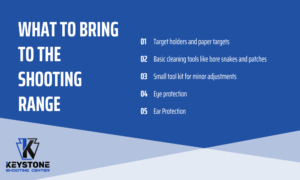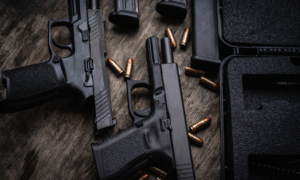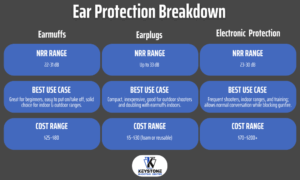When heading to the shooting range, having the right gear protects you and those around you while making your shooting experience more rewarding. Every piece of gear plays a specific role in your safety and comfort, from safety gear to helpful accessories that can improve your technique.
You’ll find practical recommendations that work for both indoor ranges and outdoor ranges, helping you make smart choices that match your shooting goals and budget.
Basic Range Safety Gear and Equipment
Eye Protection
Quality eye protection gear ranks as your first line of defense at the shooting range. All shooting glasses must meet ANSI Z87.1 safety standards, which protect against both impact and splash hazards. Standard safety gear for your eyes have features wraparound designs that block debris from all angles. For more frequent shooters, mid-range options offer anti-fog coatings and superior clarity.
If you wear prescription lenses, you have several choices. You can wear shooting glasses that fit over your regular glasses, get prescription inserts for standard shooting glasses, or invest in prescription shooting glasses. Look for polycarbonate lenses, as they provide excellent impact resistance while remaining lightweight.
Ear Protection
Proper ear protection prevents permanent hearing damage at the gun range, where noise can exceed 140 decibels. You have two main options for essential gear: earmuffs and earplugs. Earmuffs provide Noise Reduction Ratings (NRR) between 22-31 decibels for quality passive models. They’re easy to put on and take off, making them popular with new shooters.
Earplugs offer NRR ratings up to 33 decibels and come in disposable foam or reusable designs. Many experienced shooters use both plugs and muffs for maximum protection during indoor range sessions.
Electronic hearing protection equipment allows normal conversation while automatically blocking harmful gunshot noise. These systems use microphones and speakers to amplify safe sounds while cutting off during shots. While more expensive, they’re worth considering for regular range visits, as they allow clear communication with range officers and shooting partners without removing protection.
Regardless of which type you choose, proper fit matters. Earmuffs should create a complete seal around your ears, while earplugs need to be fully inserted according to the manufacturer’s instructions.
Range-Ready Clothing and Essential Gear
Appropriate Attire
Your dress code choices at the shooting range matter for both safety and comfort. Start with closed-toe shoes – no sandals or open footwear allowed. Athletic shoes or boots work well. Wear comfortable clothing that fits close to your body – loose or baggy items can catch spent brass or interfere with your shooting stance.
Pick shirts with higher necklines, as hot brass can find its way into low-cut tops. Long sleeves provide extra protection but should be fitted rather than loose. Avoid tank tops or sleeveless shirts that leave arms exposed to brass burns. For range gear, choose full-length pants that protect your legs.
Keep in mind that hot brass casings can bounce unpredictably. They may land on exposed skin or get trapped in clothing. A baseball cap helps protect your face and keeps brass from falling behind safety gear like shooting glasses.

Practical Accessories
A well-organized range bag with a main compartment holds all your shooting gear. Choose one with multiple compartments to keep equipment separated and easily accessible. Stock your range bag with:
- Target holders and paper targets
- Basic cleaning tools like bore snakes and patches
- Small tool kit for minor adjustments
- Eye protection
- Ear protection
Pack a small notepad and pen to track your practice sessions. Include lens cleaning cloths for your eye protection. A small towel helps wipe away sweat or clean equipment. Keep your range bag organized and check supplies before each range visit to ensure you have everything needed for a productive shooting experience.
Firearms and Ammunition
Firearm Options
When visiting the shooting range, you have two main options for firearms: bringing your own or using Keystone’s rental range equipment. If you own firearms, make sure they’re transported unloaded in a proper rifle case according to local regulations. Keystone’s indoor ranges offer rental services with various pistols, rifles, and shotguns available. This is perfect for first-time shooters or those wanting to try different firearms before making a purchase.
For personal firearms, confirm they meet range specifications and handgun caliber restrictions. Transport your firearm unloaded, with ammunition stored separately, in a locked hard case or soft range bag, depending on your state’s requirements.
Ammunition Needs
Ammo is straightforward but requires attention to detail. We aren’t overly restrictive but all steel-cored, steel jacketed, armor penetrating or incendiary ammo isn’t allowed. Plan on 50-100 rounds for a typical practice session. For pistols, bring two or three boxes of range-appropriate ammunition. Rifle shooters might use fewer rounds, but should have at least one full box.
Store ammunition in its original packaging or proper ammunition boxes. Keep it separate from firearms during transport. You may want to consider purchasing amo from us; our in-store prices are very competitive.
For storage, keep ammunition in a cool, dry place in its original packaging. At the firing line, only load what you plan to shoot immediately. Follow all range commands regarding loading and unloading. When finished, collect all spent brass according to range policies and safely pack any unused ammunition for transport home.
Remember that proper ammunition handling starts with choosing the right gear for your firearm. Match the caliber exactly to your firearm’s specifications, and always inspect ammunition before loading. This attention to detail helps maintain safety and gets the most from your shooting experience.

Taking Your First Shot: Essential Gear and Getting Started at the Shooting Range
Starting at the shooting range doesn’t have to break the bank. Quality eye protection, ear protection, and essential range gear typically cost $75-150 total. Many items like targets and safety gear are available at local sporting goods stores, gun shops, and online retailers. For first-time shooters, buying every piece of equipment right away isn’t necessary.
At Keystone Shooting Center, we make your range experience easy. Our rental counter provides all the basic range equipment you need, including eye and ear protection, targets, and a wide selection of firearms to try. We offer USCCA training courses and private instruction to help you learn proper technique and safety. Plus, our membership options include discounts on rentals, classes, and range time.
Ready to begin your shooting experience in a welcoming, professional environment? Visit Keystone Shooting Center in Pittsburgh. Our expert staff will help you select the right gear and get comfortable on the firing line. Call us today or book your range time online.


 Search
Search 
